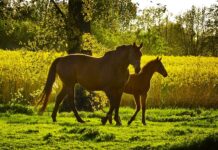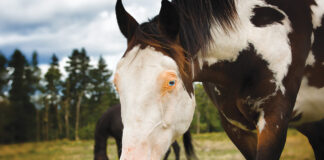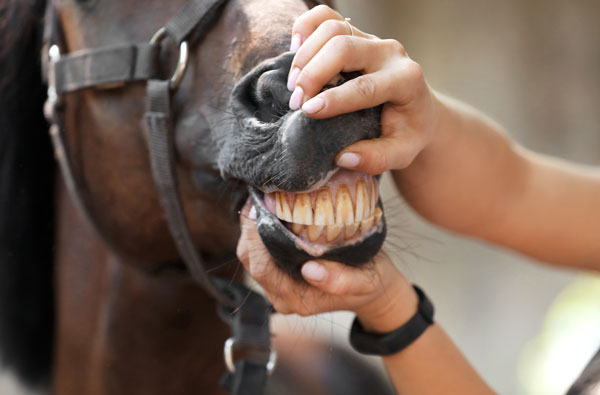
Horses’ teeth can give owners an idea of how old their animal is, but it is not an exact science. During the 18th century, horse trainer Sydney Galvayne developed “Galvayne’s Groove,” a system for telling a horse’s age by the wear patterns on a tooth’s surface. Horsemen and veterinarians long considered this an accurate predictor, but research in the 1990s proved the tool isn’t foolproof, according to Kentucky veterinarian Jack Easley, DVM, MS, ABVP, AVDC (Eq).
While teeth can’t be used to determine a specific age, Easley says changes to the horse’s teeth can be used to group horses into four age categories: birth to age 4, 5 to 10, 10 to 15 and over 15 years of age. Assessing an older horse’s age is based on tooth wear, whereas gauging a young horse’s age is based on the teeth present, those being shed and new ones erupting through the gum line. Easley describes the tooth characteristics he looks for when approximating a horse’s age.
Baby Teeth
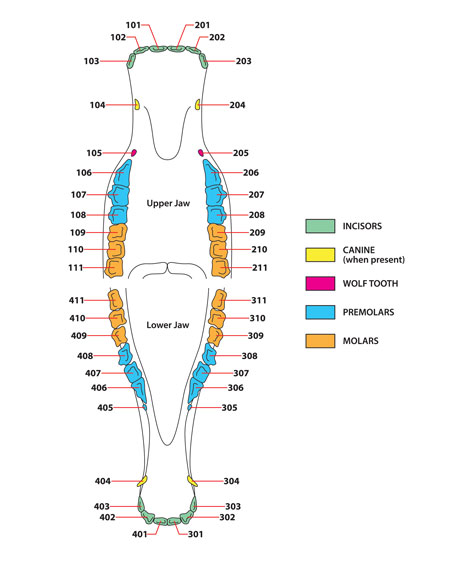
Shortly after birth, baby (deciduous) teeth emerge on a fairly regular schedule that includes eruption, shedding and the appearance of permanent teeth. The cycle continues slowly through age five. The first teeth to emerge are the central incisors. Between six and nine months of age, three sets of premolars have also grown in.
“They erupt their incisor teeth in the front first,” he says. “The premolars in the back of their mouth come next, and then at a year of age, they start erupting permanent teeth.”
The process of gaining, losing and replacing baby teeth follows a general timeline, but can vary based on the individual horse. Easley compares the teething process in horses to that of children to illustrate how varied the cycle can be.
“If you look at a classroom of first graders, some of them are missing teeth, others already have permanent teeth, and others all baby teeth,” says Easley. “The erupting and shedding of teeth happens on a bell curve that gives an average age over six to nine months.”
Adult Horse Teeth
By age five, most horses have all 36 total permanent teeth. That includes 12 incisors and 24 cheek teeth. Not all horses have wolf or canine teeth, but in horses that have them, they emerge around age 4. Between ages 5 and 10, a horse’s teeth has cups or indentations on the surface. The cup area is surrounded by enamel and tends to be darker. Over time, the cups fade, providing clues to the horse’s age.
By the time a horse reaches 10, Easley says those cups have disappeared and is replaced by a mark on the tooth called a dental star. At the same time, the chewing edge of the tooth begins to become more rounded than oval-shaped. Hooks begin to develop on the upper-corner incisors around this time, but eventually wear off by the horse’s teenage years.
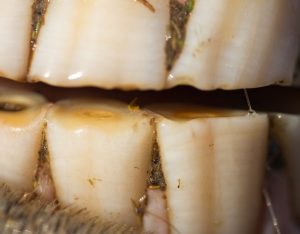
“Once the horse is over 15, then they start to lose the dental star and the tooth is a shaped a little differently,” he says. “From 5-10 years, the occlusal surface of the teeth change shape from an oval, side-to-side direction to a trapezoid shape. Around the age of 15 up until 20, they are more in a triangular shape. As a senior horse, the teeth become more round and then oval in a front-to-back direction.”
Additionally, as horses age, their incisors slant forward and form a point at the spot where the central upper and lower teeth come in contact. The gums are also an indicator of age. On young horses, the gum line runs nearly straight along the tooth, but sags in older horses.
Outside Influences
Tooth wear isn’t a foolproof tool for telling a horse’s age because changes in the horse’s teeth can be influenced by genetics, nutrition, the environment and management practices. For example, permanent teeth in Standardbreds, draft and Miniature Horses tend to appear later than in stock breeds. What the horse is eating can also influence how old their teeth look.
“Horses that eat mainly grass are wearing down their teeth at a much faster rate, because grasses on sandy soils contain high levels of pumice materials known as biological silicate,” explains Easley. “The horse may only be eight, but his teeth may look like a 10- or 12-year-old.”
Mouth injuries caused by a kick to the face or a bit can change the way a horse’s teeth looks or discourage teeth from emerging at all. That too can complicate the process for determining age by the teeth alone.
The bottom line is that it isn’t an exact science, but there are several clues your veterinarian can use to help determine a horse’s age, if it is unknown. So ask away on your horse’s next dental exam.


